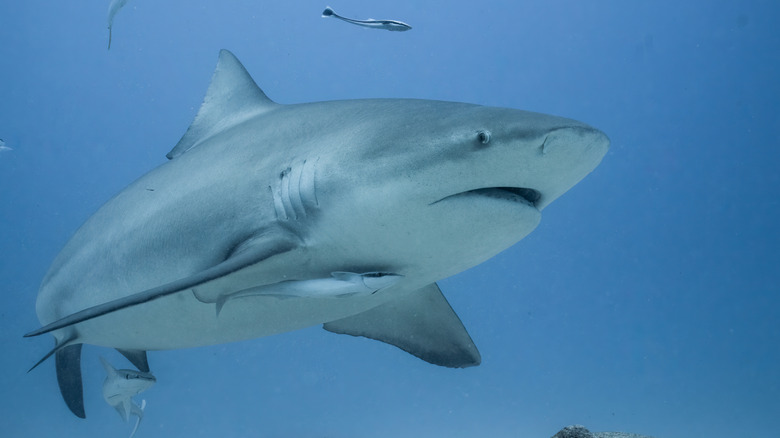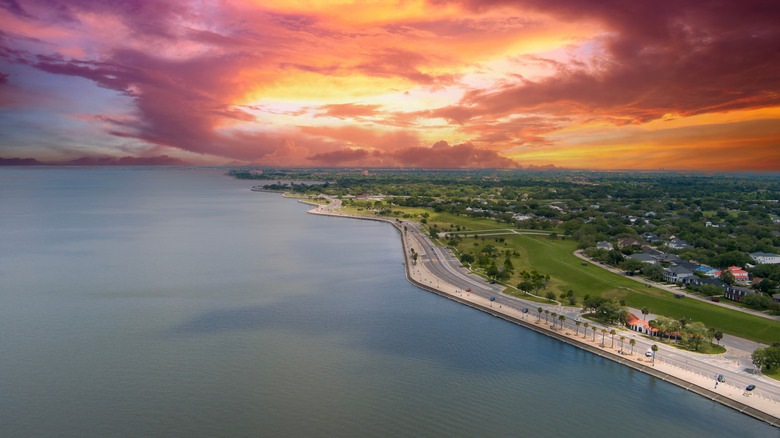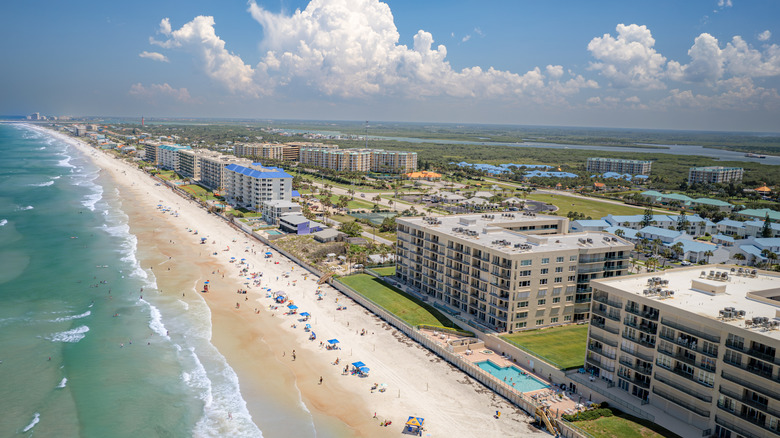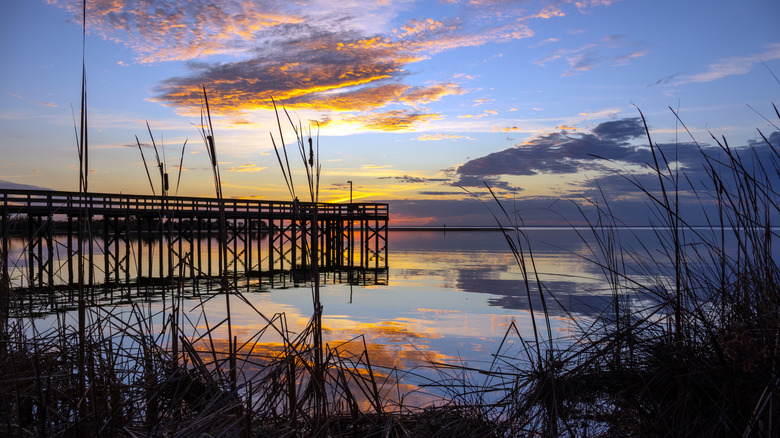America's 5 Most Popular Waters That Are Full Of Deadly Bull Sharks
While World War I raged across Europe, another horrific series of events was capturing headlines: The 1916 shark attacks, during which four people were killed by sharks and another was injured. Bizarrely, these attacks took place not in the open ocean, but at the Jersey Shore, in a nearby lake, and in an inland creek. These shocking attacks transformed sharks into murderous monsters in the public's eyes — a perception that still exists today.
While there's no way to know for certain, it's believed the shark or sharks involved may have been bull sharks, which can live in fresh water, brackish water, and saltwater worldwide. They have even been seen in landlocked Illinois after swimming up the Mississippi. After detailed research into some of the most visited water recreation areas known to be home to bull sharks, we narrowed our list down to Louisiana's Lake Pontchartrain, the area off the Florida coast in Volusia County and further south in Palm Beach, Texas's Galveston Bay, and Alabama's Mobile Bay.
Despite their reputation, sharks typically don't harm humans. When they do, it's more about curiosity (investigating something with the only tool they have: a mouth full of teeth) or mistaken identity (they thought it was a delicious seal). Unfortunately, bull sharks prefer shallow waters where humans often are, and can be territorial. Over the past 25 years, there have only been 30 unprovoked attacks (meaning the person who was bitten was minding their own business, not pulling a shark onto a boat in hopes of eating it), and only one of those was fatal. But there's no denying that these sharks can be deadly, and people entering areas where bull sharks are common should proceed with caution.
Lake Pontchartrain
While visiting New Orleans, Louisiana, you might drive across America's largest bridge to reach it from the North Shore. But might you spot pointy dorsal fins sticking up out of the water as you drive? Lake Pontchartrain is an impressive 630-square-foot estuary, known for its unique landscape and the wildlife that thrives in its brackish waters. That includes bull sharks. This body of water is an extremely popular spot for locals to boat, and visitors often rent canoes and paddle boards, too. Many even swim in Lake Pontchartrain, though there are some serious concerns about the water quality, especially after heavy rains. It's not known exactly how many people enjoy the lake, but considering it is close to the state's largest city and tens of thousands of people drive across the causeway every single day, it's safe to say the number is high.
In the summers, it's common for juvenile bull sharks between four and five feet long to visit the lake — though older, larger sharks as long as 6 feet have been spotted, too. Some have even been tagged so that researchers can follow their journeys in and out of Lake Potchartrain. It's not unlikely for people, especially those around the North Shore, near the swimming beach and boat launch in the Seabrook area, or near Goose Point by Fontainebleau State Park, to see them in the water. In 2014, a young child swimming in Lake Pontchartrain was bitten by a shark, but suffered no lasting damage. Almost exactly a century earlier, a teenage swimmer was killed by a shark. Hopefully, you won't have to worry about another attack for another hundred years — but you should still proceed with caution.
Volusia County coast
Volusia County has 47 miles of brilliant, beachy shore, including some of the most famous and popular beach cities in Florida, such as New Smyrna Beach and Daytona Beach. This stretch of the Atlantic is known for its blue waves and white sand beaches, but it has another reputation, too. They just might be Florida's two most shark-filled beaches. In fact, the United States records more shark bites than any other country in the world. Florida leads the nation in shark attacks, and Volusia County has more than any other county in the state. What all that means is that this popular spring break destination is also the spot where you're most likely to get nipped by a shark if you're in the water.
There are a few different kinds of sharks swimming off the Volusia County coast, but many of them are bull sharks. Reports of shark bites in this area date back to the Gilded Age. While the vast majority of bites around New Smyrna Beach (known as the "Shark Bite Capital") are mild — not even requiring stitches — it's definitely not something that you want to risk if you can avoid it. As invigorating as a solo dawn swim off the Volusia County coast might be, and as gorgeous as the setting sun looks glimmering off the waves off Daytona Beach, you should opt for a jog along the beach instead — dawn and dusk are when the sharks are most likely to be active. You shouldn't be swimming alone, either. No matter what time it is, if you see a lot of smaller fish schooling and leaping from the surface, get out of the water before a shark mistakes you for one of their snacks.
Palm Beach
While there might be more reported shark bites in central Florida, further down the east coast, South Florida has plenty of bull sharks swimming around its beaches, too. Palm Beach County — including its barrier islands – is more popular than ever, with millions of visitors drawn by luxury seaside resorts and yachts on the brilliant blue waves. Under the surface, you might find a variety of sharks, including blacktips, tiger sharks, nurse sharks, great whites, and of course, bull sharks. While shark bites are extremely rare everywhere, this small, popular stretch has seen more than its fair share.
Sharks are most common in the waters off the coast of Palm Beach in the winter. When it starts to get too chilly for them elsewhere, they migrate south. At the right time, people flying drones or taking helicopter rides over the water can see deep into those famously clear Palm Beach waves and see thousands of sharks moving beneath the surface. Not everyone tries to avoid bull sharks here. It's a popular destination for underwater wildlife photographers who freedive, swim among the sharks, and take photos of them in their natural habitat beneath the waves.
Galveston Bay
When you imagine landscapes in the Lone Star State, you probably think of plains and wide open blue skies — but each year, millions of people visit the beautiful Texas coast. Texas has quiet sand beaches near Galveston, along with the diverse ecosystem of Galveston Bay, the large estuary where freshwater flows into the briny waves. This unique area is packed with wildlife, from pelicans to sea turtles. It's also a safe haven for numerous shark species, including bull sharks. It's an ideal nursing environment for baby sharks to survive and thrive, so mother sharks often birth their young where freshwater enters the estuary. As the pups grow larger and stronger, they make their way toward the open gulf.
While it might seem unusual for there to be sharks in Texas if you haven't heard much about it, bull sharks are in fact a fundamental part of this ecosystem. Adult bull sharks often feed in the ocean and then return to Galveston Bay to rest. When they excrete waste, they bring different nutrients to the bay, which would not have been there otherwise. There have only been 17 reported shark bites in Galveston in the last centuy, and there hasn't been a confirmed fatal shark attack there since 1962. Most swimmers never even notice the sharks just below the surface, but they are there. If you're planning to swim in Galveston Bay or surrounding waters, proceed with caution. Never swim in schools of tasty fish, leave them alone if you do spot them, and exit the water if you have a bleeding cut (you should never swim in the ocean with an open cut, anyway).
Mobile Bay
Alabama's coastal communities around Mobile Bay are beloved for their local seafood spots, and millions of travelers flock to the area. As global temperatures rise and the waters of Mobile Bay stay warmer, it's also attracting a lot more young bull sharks. In fact, a 2024 study published in Scientific Reports found that there are about five times more "juvenile" bull sharks in the bay than there were 20 years ago. As more and more baby bull sharks born in the bay choose to stay farther north longer, humans are more likely to see them. While it is a hotspot for baby and juvenile bull sharks, larger adults appear in Mobile Bay from time to time, too.
While there's no denying that Mobile Bay has a lot of bull sharks — and numbers are only going to increase – bites are still unlikely as long as you aren't fishing there, pulling in tantalizing shark meals on your line, or actively engaging a shark on purpose. That doesn't mean it's impossible, though. To stay safe in and around Mobile Bay and the rest of Alabama's coastal waters, it's a good idea to heed the Alabama Department of Conservation and Natural Resources' shark alert system, which notifies beachgoers via notifications to their phones if a shark has been spotted nearby, as well as giving lifeguards and EMS a heads up. If you don't bring your phone to the beach, don't worry. There should also be beach flags warning you when sharks have been spotted.
Methodology
While bull sharks have been spotted all along the East Coast of the United States and throughout the Gulf of Mexico (renamed the Gulf of America in 2025 by U.S. President Donald Trump), for this list, we focused only on places where regular bull shark activity has been confirmed, through credible sources ranging from social media sightings and news reports to statistics about shark populations. We also wanted to highlight destinations that attract a large number of people for recreation — the kinds of places where our readers might already be visiting or planning a trip to. This criterion ruled out some interesting spots like Texas' Sabine Lake, a major hub for baby bull sharks, but only receives about 300,000 annual visitors.
We also combined Florida's popular Daytona Beach and New Smyrna Beach into a single entry because they are in the same county and lie less than 15 miles apart. Migrating bull sharks have been documented traveling vast distances and are believed to be able to routinely swim more than 100 miles in a single day, making it highly likely that the sharks seen at both beaches are the same individuals. While bull sharks migrate up and down the coast in general, and could theoretically be spotted in multiple locations, these were the only two well-known bull shark hotspots close enough to be considered the same waters.






